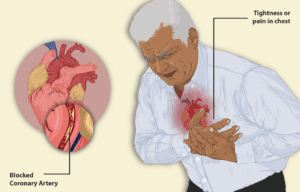Fibromyalgia, also known as fibromyalgia syndrome (FMS), is a chronic condition with widespread and generalized musculoskeletal pain in the whole body and consequent disability. “Fibro” means fiber and “myalgia” means muscle pain. It is the most common chronic diffuse musculoskeletal pain syndrome. It is usually misdiagnosed and difficult to understand as its signs and symptoms often mimic other diseases.
Epidemiology
- Incidence: Fibromyalgia occurs in 3 to 10% of the general population. Some estimates suggest nearly 1 in 20 people may be affected by fibromyalgia to some degree. Risk of fibromyalgia increases in patients with previously diagnosed rheumatic diseases (such as osteoarthritis, lupus, rheumatoid arthritis, or ankylosing spondylitis)
- Sex: women are more affected than men (10:1)
- Age: Most frequently develop in the age group 20 to 50 years. Its incidence increases with age and reaches a peak of 7% in women aged over 70 years.
Pathophysiology of fibromyalgia syndrome
- The exact cause of fibromyalgia syndrome is yet to be discovered.
- Fibromyalgia is not an autoimmune or inflammatory disorder but current research suggests an involvement of the central nervous system.
- It is thought to be related to an increase in levels of certain chemical mediators and neurotransmitters in the brain that signal pain (neurotransmitters) and changes in the way the central nervous system processes pain sensation carried around the body.
- Several hypotheses have been developed including “central sensitization”. This theory suggests that people with fibromyalgia have a lower threshold for pain because of the increased reactivity of pain-sensitive nerve cells in the spinal cord or brain.
Triggering/precipitating factors:
-
- Genetic association
- It may be inherited from families
- Certain gene mutation may be responsible
- Infections (Hepatitis C, Lyme disease, EBV)
- Physical trauma leading to post-traumatic stress (such as after car accident)
- Physiological/emotional stress
- Genetic association

Symptoms of fibromyalgia
General:
- Widespread chronic pain (more than 3 months) usually on the back and neck
- Extreme tiredness (fatigue) mostly in the morning
- Unrefreshing sleep
- Mental disturbances (Fibromyalgia fog – also known as “fibro fog” or “brain fog”)
- memory lapses
- difficulty concentrating
- trouble staying alert
- Depression
- Anxiety
Locomotive symptoms:
- Early-morning muscle stiffness
- The feeling of swelling in hands
- Distal finger tingling
Non-locomotive symptoms/Additional symptoms:
- Headaches/migraines
- Irritable bowel syndrome (colicky abdominal pain, variable bowel habits etc.)
- Irritable bladder (Bladder fullness, nocturnal frequency)
- Allodynia (pain in response to non-painful stimuli)
- Hyperesthesia (exaggerated perception of pain in response to mildly painful stimuli)
- Frequent side-effects with drugs (chemical sensitivity)
Diagnosis of fibromyalgia syndrome
- There are no specific laboratory tests for fibromyalgia. Certain routine blood tests or imaging is done to exclude other conditions.
- Mostly clinical – history and physical examinations
- History
- Widespread musculoskeletal pain
- Occurring for more than 3 months
- Associated with fatigue and sleeping difficulty
- Additional features such as headache/IBS/mental disturbances etc
- Physical examinations:
- Focal musculoskeletal tenderness
- No joint swelling or signs of inflammation
- History
The diagnosis of fibromyalgia syndrome according to the old guideline is by exerting pressure ( of 4kg/m^2) on 18 small spots each about the size of a square centimeter located throughout the body. These spots are known as tender points. For the diagnosis, pain in 11 out of 18 tender points are required.
Location: The tender points of fibromyalgia syndrome (FMS) are located around the neck, shoulders, elbows, chest, hips, and knees. They’re located symmetrically on both sides of the body.
Characteristics of pain: One of the defining characteristics of fibromyalgia is that the pain usually fluctuates. It may come and go, move around, or vary widely in intensity from day to day.
Differential diagnosis
Infections
-
- Lyme disease
- Hepatitis C
- HIV infections
Rheumatological diseases:
-
- Rheumatoid arthritis
- SLE
- Sjogren’s syndrome
- Ankylosing spondylitis
- Polymyalgia rheumatica
- Peripheral neuropathies
Neurological
-
- Multiple sclerosis
- Myasthenia gravis
Endocrinopathies
-
- Hypo/hyperthyroidism
- Cushing syndrome
- Diabetes
Management
Aim of treatment:
- Educate the patient about the condition, address unresolved psychological issues, achieve pain control, and improve sleep.
- Reduce symptoms and improve quality of life.
Currently, there isn’t a cure for fibromyalgia. It requires a multidisciplinary approach that includes a rheumatologist, neurologist, and psychologist and a combination of medication and lifestyle changes.
Pharmacological Approach
- Pain reliever:
Note: Steroids not advised, because FM is not an inflammatory disease and also they can lead to dependence and may even worsen the pain over time.
- Antidepressants:
-
- Low-dose TCA (amitriptyline) once daily orally at night
- Low dose SNRI (Duloxetine)
- Milnacipran
- GABA analogues:
-
- Gabapentin
- Pregabalin
Non-pharmacological Approach
Therapies
Various therapies can potentially reduce the stress that triggers fibromyalgia symptoms and depression. These include:
- Physiotherapy can improve strength, flexibility, and stamina.
- Long-term graded exercise (both aerobic exercise and strength-based such as swimming, cycling, walking, etc.) to improve well-being, sleep quality, and functional capacity.
- Cognitive Behavioral therapy.
- Complementary therapies such as:
-
- Massage
- Acupuncture, and
- Chiropractic manipulation etc.
Counseling
Talking with a counselor can help to deal with stressful situations. Patients should be advised that there is no one specific treatment that is guaranteed to work. Wherever possible, counseling sessions should include the spouse, family, or caregiver.
Lifestyle Modifications
Patient self-care is vital to improve symptoms and daily functions.
- Make time to relax each day.
- Avoid overexertion
- Set a regular sleep pattern
- Yoga and meditation
- A balanced and healthy diet
- Eat fruits and vegetables, along with whole grains, low-fat dairy, and lean protein.
- Drink plenty of water.
- Eat more plants than meat.
- Reduce the amount of sugar in the diet.
Prognosis
Prognosis is variable. Fibromyalgia syndrome (FMS) can last a long time but it neither results in tissue damage nor is it an organ-threatening disease. However, some patients with fibromyalgia continue to suffer from long-term widespread pain while many others overcome their sense of well-being and experience a dramatic reduction in pain and it improves to pain levels that are more moderate with the treatments discussed above.



